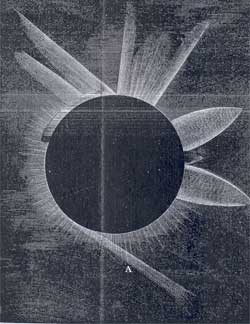
Sun-Earth Day Presents: Eclipse, In a Different Light
Astronomers found solar eclipses an exciting challenge to render as the eclipse flashed by, and at a time when photography was still in its infancy.
TECHNOLOGY THROUGH TIME ISSUE #41: A GALLERY OF ECLIPSE DRAWINGS

Drawing from the 1889 book "A Handbook of Descriptive and Practical Astronomy" by George Chambers (Clarendon Press:London).
Before the techniques and technology of astronomical photography were properly worked out, astronomers and other talented recorders learned how to be quick at the draw to render solar details in the brief few minutes they were on display. Every total solar eclipse since ca 1800 has had its likeness sketched, usually with the help of a telescope. You can find these sketches in textbooks and news reports from the 1800’s. When you consider how detailed some of these drawings are, and that eclipses last only a few minutes, it is easy to imagine how frantically the artist had to draw to capture every nuance of the fleeting view before the sun’s blinding light obliterated the view once more.
As observers became more familiar with what was to be seen, a steady improvement can be seen in the details that are rendered, with a little help from the sun’s ever changing activity during each eclipse. For example, during solar maximum years ( e.g. 1838, 1849, 1860, 1871, 1882, 1893) eclipses had more dramatic corona than during solar minimum years ( e.g. 1835, 1845, 1856, 1867, 1879, 1890 and 1901).
Here are a few examples:
RELATED SITES
Technology Through Time
ISSUES
- #46: The Magnetic Sun
- #45: Coronagraph
- #44: Einstein
- #43: Coronium
- #42: The Sun - In a Different Light
- #41: Gallery of Drawings
- #40: First Sun Photo
- #39: Solar Spectroscopy
- #38: George Ellery Hale
- #37: Coronal Mass Ejections
- #36: First Corona Descriptions
- #35: First Sunspot Drawing
- #34: Ptolemy
- #33: Ancient Greece
- #32: Ancient Babylon
- #31: Galileo Galilei
Eclipse Fact
There are at least 2 solar eclipses per year somewhere on the Earth.












